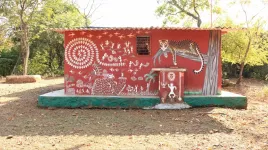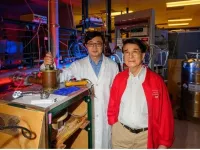(Press-News.org) Nonprofits and companies planting trees in the tropics may often pick species for their commercial rather than ecological value, researchers found in a new analysis of organizations' publicly available data. They also found many may not have tracked the trees' survival.
Tree planting is a promising, but controversial, restoration strategy for fighting climate change. A new study in the journal Biological Conservation provides a detailed look at what restoration organizations across the tropics are actually doing on the ground.
"We found some organizations placed an emphasis on biological diversity and forest restoration in their mission statements. When we looked at the species they reported planting, many organizations reported planting commercial species, with chocolate, mango and teak in the top five," said the study's first author Meredith Martin, assistant professor of forestry and environmental resources at NC State. Martin led the study with researchers from The Nature Conservancy, a nonprofit that was also included in the analysis.
For the study, researchers analyzed publicly available data from websites and annual reports for 136 nonprofits and 38 for-profit companies, gathered using internet searches and referrals from Yale University's Environmental Leadership and Training Initiative. Their analysis included projects focused on forest conservation, economic development, or humanitarian aims in 74 different countries, all located in the tropics or subtropics. Brazil, Kenya and Indonesia were the countries with the largest number of projects.
Of these organizations, 118 reported the numbers of trees they planted. In total, they reported planting a total of 1.4 billion trees since 1961. At their estimated average rate of planting in the tropics, it would take more than a thousand years to plant a trillion trees - a goal set by at least three global initiatives.
Organizations reported planting a total of 682 species - a fraction of the roughly 50,000 species of trees found in the tropics, Martin said. Without having access to data about numbers of trees planted by species, they estimated the percentage of organizations planting certain species. The most commonly reported species, ranked by number of projects reporting those species, were cacao, teak, moringa, mango and coffee.
Nearly half of the groups didn't mention their planting method. The most common planting method was agroforestry, which is the integration of trees into animal or crop farming operations. Ten percent talked about planting using assisted regeneration, seven percent focused on enrichment planting, and two percent focused on natural regeneration.
"There's been a lot of research looking at natural regeneration, which is protecting a forest and letting it regrow," Martin said. "It can be cheaper, and more effective in terms of accumulating biomass and species diversity. There are also ways of assisting regeneration to encourage the species you want."
Thirty-two individual organizations mentioned monitoring tree survival. Of those, eight mentioned measuring survival rates and seven mentioned maintenance of plantings. Three groups gave detailed information about monitoring, and two mentioned they worked with outside groups for monitoring or certification.
"If you're not monitoring whether the trees you're planting are surviving, or taking steps to ensure they're surviving or growing, that could be a waste of money and effort," Martin said.
Researchers say the findings are important as groups increasingly look to plant trees to mitigate climate change.
"Trees are natural and incredibly efficient carbon capture entities," Martin said. "They're also living organisms. They're not just machines we can put down anywhere. Organizations need to be thoughtful about what species they are going to use and how they make sure they match the environment, as well as tracking to make sure they're not wasting money on something that doesn't work."
INFORMATION:
The study, "People plant trees for utility more often than for biodiversity or carbon," was published online in Biological Conservation on July 7, 2021. In addition to Martin, the other authors were David J. Woodbury, Danica A. Doroski, Eliot Nagele, Michael Storace, Susan C. Cook-Patton, Rachel Pasternack and Mark S. Ashton. Funding was provided by The Nature Conservancy to Yale University under grant No. P117456, GLT Global Forestry and Wood Products. Martin completed the work while based at Yale.
Note to editors: The abstract follows.
"People plant trees for utility more often than for biodiversity or carbon"
Authors: Meredith Martin, David J. Woodbury, Danica A. Doroski, Eliot Nagele, Michael Storace, Susan C. Cook-Patton, Rachel Pasternack and Mark S. Ashton.
Published online July 7, 2021, in Biological Conservation.
DOI: 10.1016/j.biocon.2021.109224
Abstract: Tree planting is both a promising and controversial solution to climate change and biodiversity loss. However, this controversy is largely theoretical because we lack detailed information of how tree planting is proceeding on-the-ground. Here, we compiled a pantropical dataset of 174 tree planting organizations to determine the type of organizations involved in tree planting, their geographic locations and tree planting approaches. We found that the number of organizations have increased by 288% in the past 30 years, especially for-profit organizations. These organizations reported planting nearly 1.4 billion trees across 74 countries since 1961. Most frequently organizations reported establishing agroforestry systems or mixed species and single species plantations or using assisted natural regeneration suggesting that tree planting programs are designed to support local communities as well as environmental objectives. Moreover, the most frequently reported species were commercial or utilitarian, with the top five including cacao, teak, moringa, mango and coffee. Finally, despite widespread efforts to plant more trees, there was a pronounced lack of monitoring on websites and in reports; only 18% of organizations mention monitoring at all, and only 5% mention measuring survival rate of plantings. Greater transparency and greater communication are needed between planting organizations and researchers to apply the most effective ways to restore forest cover. Further, while organizations often aimed to counter environmental problems, the use of the same sets of commercially useful species to meet economic development goals across the global indicates a need for greater coordination among organizations to avoid biotic homogenization.
Major ecosystem changes like sea-level rise, desertification and lake warming are fueling uncertainty about the future. Many initiatives - such as those fighting to fully eradicate non-native species, or to combat wildfires - focus on actively resisting change to preserve a slice of the past.
However, resisting ecosystem transformation is not always a feasible approach. According to a new paper published today in the Ecological Society of America's journal Frontiers in Ecology and the Environment, accepting and directing ecosystem change are also viable responses, and should not necessarily be viewed as fallback options or as last resorts. The paper presents a set of guiding principles for applying a "RAD" strategy - a framework that involves ...
BENGALURU, India (July 8, 2021) - A new study led by WCS-India documents how a big cat deity worshipped by Indigenous Peoples facilitates coexistence between humans and leopards.
The study, published in a special issue of the journal Frontiers in Conservation Science: Human-Wildlife Dynamics called Understanding Coexistence with Wildlife documents how the Indigenous Warli people of Maharashtra, India, worship Waghoba, a leopard/tiger deity to gain protection from leopards, and how they have lived side-by-side with them for centuries (formerly tigers, too). The researchers have identified over 150 shrines dedicated ...
Researchers at Johns Hopkins Medicine have shown that a type of echocardiogram, a common test to evaluate whether a person's heart is pumping properly, may be useful in predicting which patients with COVID-19 are most at risk of developing atrial fibrillation -- an irregular heartbeat that can increase a person's risk for heart failure and stroke, among other heart issues. The new findings, END ...
Ever since the 1986 discovery that copper oxide materials, or cuprates, could carry electrical current with no loss at unexpectedly high temperatures, scientists have been looking for other unconventional superconductors that could operate even closer to room temperature. This would allow for a host of everyday applications that could transform society by making energy transmission more efficient, for instance.
Nickel oxides, or nickelates, seemed like a promising candidate. They're based on nickel, which sits next to copper on the periodic table, and the two elements have some common characteristics. It ...
Conditions in the tropical ocean affect weather patterns worldwide. The most well-known examples are El Niño or La Niña events, but scientists believe other key elements of the tropical climate remain undiscovered.
In a study recently published in Geophysical Research Letters, scientists from the University of Washington and NOAA's Pacific Marine Environmental Laboratory use remotely-piloted sailboats to gather data on cold air pools, or pockets of cooler air that form below tropical storm clouds.
"Atmospheric cold pools are cold air masses that flow outward beneath intense thunderstorms and alter the surrounding environment," ...
In a critical next step toward room-temperature superconductivity at ambient pressure, Paul Chu, Founding Director and Chief Scientist at the Texas Center for Superconductivity at the University of Houston (TcSUH), Liangzi Deng, research assistant professor of physics at TcSUH, and their colleagues at TcSUH conceived and developed a pressure-quench (PQ) technique that retains the pressure-enhanced and/or -induced high transition temperature (Tc) phase even after the removal of the applied pressure that generates this phase.
Pengcheng Dai, professor of physics and astronomy at Rice University and his group, and Yanming Ma, Dean of the College of Physics ...
The Large High Altitude Air Shower Observatory (LHAASO), one of China's key national science and technology infrastructure facilities, has accurately measured the brightness over 3.5 orders of magnitude of the standard candle in high-energy astronomy, thus calibrating a new standard for ultra-high-energy (UHE) gamma-ray sources. The standard candle is the famous Crab Nebula, which evolved from the "guest star" recorded by the imperial astronomers of China's Song Dynasty.
LHAASO has also discovered a photon with an energy of 1.1 PeV (1 PeV = one quadrillion electronvolts), indicating the presence of an extremely powerful electron accelerator--about one-tenth the size of the solar system--located in the core ...
As tectonic plates slip past each other, the rivers that cross fault lines change shape. The shifting ground stretches the river channels until the water breaks its course and flows onto new paths.
In a study published July 9 in Science, researchers at UC Santa Cruz created a model that helps predict this process. It provides broad context to how rivers and faults interact to shape the nearby topography.
The group originally planned to use the San Andreas fault in the Carrizo Plain of California to study how fault movement shapes the landscapes near rivers. But after spending hours pouring over aerial imagery and remote topographic data, their understanding of how the terrain evolves began to change. They realized that rivers play a more active ...
For the first time, Princess Margaret researchers have mapped out where and how leukemia begins and develops in infants with Down syndrome in preclinical models, paving the way to potentially prevent this cancer in the future.
Children with Down syndrome have a 150-fold increased risk of developing myeloid leukemia within the first five years of their life. Yet the mechanism by which the extra copy of chromosome 21 predisposes to leukemia remains unclear.
Down syndrome is a genetic disorder caused by a random error in cell division in early human development that results in an extra copy of chromosome 21. This extra copy is what causes the developmental changes and physical ...
Proactive, frequent rapid testing of all students for COVID-19 is more effective at preventing large transmission clusters in schools than measures that are only initiated when someone develops symptoms and then tests positive, Simon Fraser University researchers have found. Professors Caroline Colijn and Paul Tupper used a mathematical model to simulate COVID-19's spread in the classroom and published their research results today in the journal PLOS Computational Biology.
The simulations showed that, in a classroom with 25 students, anywhere from zero to 20 students might be infected after exposure, depending on even small adjustments ...






